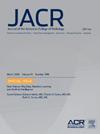女性退伍军人乳房x光检查的利用:来自全国健康访谈调查的横断面调查结果。
IF 5.1
3区 医学
Q1 RADIOLOGY, NUCLEAR MEDICINE & MEDICAL IMAGING
引用次数: 0
摘要
目的:尽管女性是所有军种中增长最快的退伍军人群体,但关于女性退伍军人乳房x光检查利用的数据有限。通过一项具有全国代表性的横断面调查,我们评估了退伍军人身份与乳房x光检查之间的关系。方法:纳入2019年全国健康访谈调查中年龄在40 ~ 74岁、无乳腺癌病史的女性受访者。根据退伍军人身份,估计了去年接受乳房x光检查的患者比例。逻辑回归分析评估了筛查与退伍军人身份之间的关系,并对潜在的混杂因素进行了调整。分析考虑了复杂的调查抽样设计,以获得对平民,非机构的美国人口的有效估计。结果:总共有8,996名女性受访者符合纳入标准(退伍军人1.9%[估计有1,190,169名妇女],军人医疗保险3.2%[估计有2,156,863名妇女])。在退伍军人中,57.9%的人报告在去年进行了乳房x光检查,55.2%的非退伍军人报告在去年进行了乳房x光检查。退伍军人身份与乳房x线摄影筛查百分比的差异无关(P = 0.959)。在有医疗保险的调查参与者中,军人医疗保险与乳房x光检查百分比的差异无关(P = 0.132)。结论:在我们的未调整和调整分析中,女性退伍军人接受乳房x光检查的可能性相当。在美国,有超过100万的女性退伍军人有资格接受乳房x光检查,放射学实践应该设计积极的外展策略,以解决由于军事环境暴露而可能面临乳腺癌风险增加的退伍军人的需求。本文章由计算机程序翻译,如有差异,请以英文原文为准。
Mammography Screening Utilization in Female Veterans Using Cross-Sectional Survey Results from the National Health Interview Survey
Purpose
Although women are the fastest growing group of veterans across all military branches, there are limited data about mammography screening utilization in female veterans. Using a nationally representative cross-sectional survey, we evaluated the association between veteran status and mammography screening.
Methods
Female survey respondents aged 40 to 74 in the 2019 National Health Interview Survey without history of breast cancer were included. The proportion of patients who reported undergoing mammography screening in the last year was estimated, stratified by veteran status. Logistic regression analyses evaluated the association between screening and veteran status, adjusted for potential confounders. Analyses accounted for complex survey sampling design to obtain valid estimates for the civilian, noninstitutionalized US population.
Results
In all, 8,996 female survey respondents met inclusion criteria (veterans 1.9% [estimated 1,190,169 women], military health coverage 3.2% [estimated 2,156,863 women]). Of the veterans, 57.9% reported screening mammography within the last year, and 55.2% of nonveterans reported screening mammography within the last year. Veteran status was not associated with differences in mammography screening percentages (P = .959). Among survey participants with health insurance, military health insurance was not associated with differences in mammography screening percentages (P = .132).
Conclusions
Female veterans were comparably likely to undergo mammography screening in our unadjusted and adjusted analyses. With more than 1 million female veterans and growing eligible for mammography screening in the United States, radiology practices should design proactive outreach strategies to address the needs of veterans who may face increased breast cancer risk due to military environmental exposures.
求助全文
通过发布文献求助,成功后即可免费获取论文全文。
去求助
来源期刊

Journal of the American College of Radiology
RADIOLOGY, NUCLEAR MEDICINE & MEDICAL IMAGING-
CiteScore
6.30
自引率
8.90%
发文量
312
审稿时长
34 days
期刊介绍:
The official journal of the American College of Radiology, JACR informs its readers of timely, pertinent, and important topics affecting the practice of diagnostic radiologists, interventional radiologists, medical physicists, and radiation oncologists. In so doing, JACR improves their practices and helps optimize their role in the health care system. By providing a forum for informative, well-written articles on health policy, clinical practice, practice management, data science, and education, JACR engages readers in a dialogue that ultimately benefits patient care.
 求助内容:
求助内容: 应助结果提醒方式:
应助结果提醒方式:


